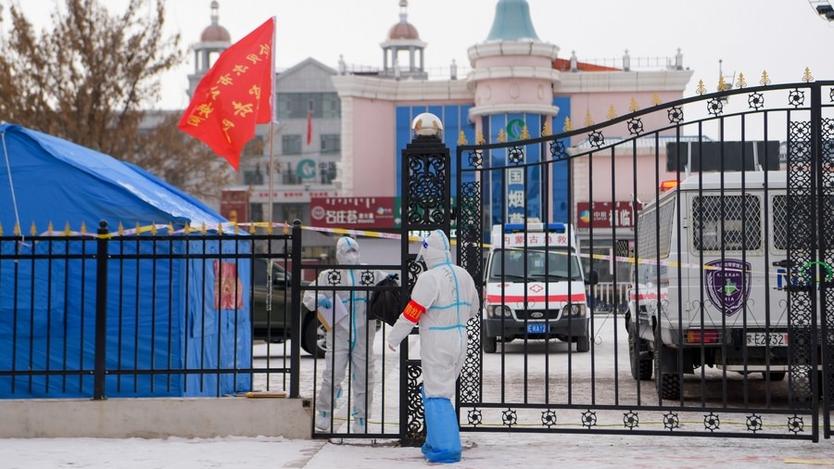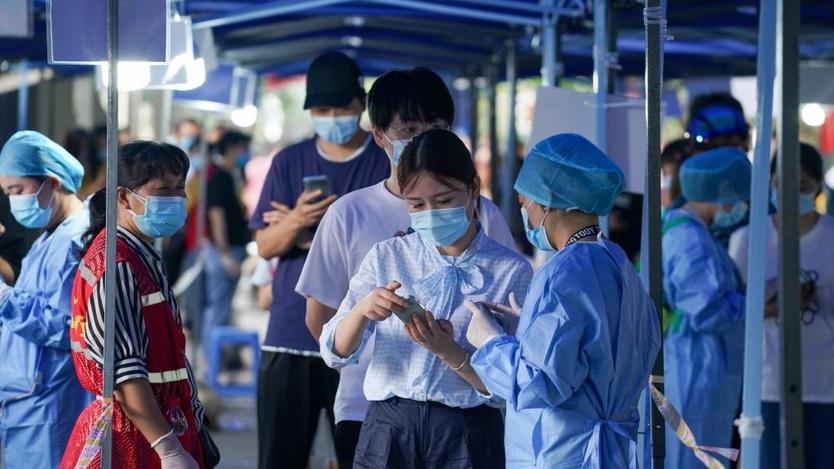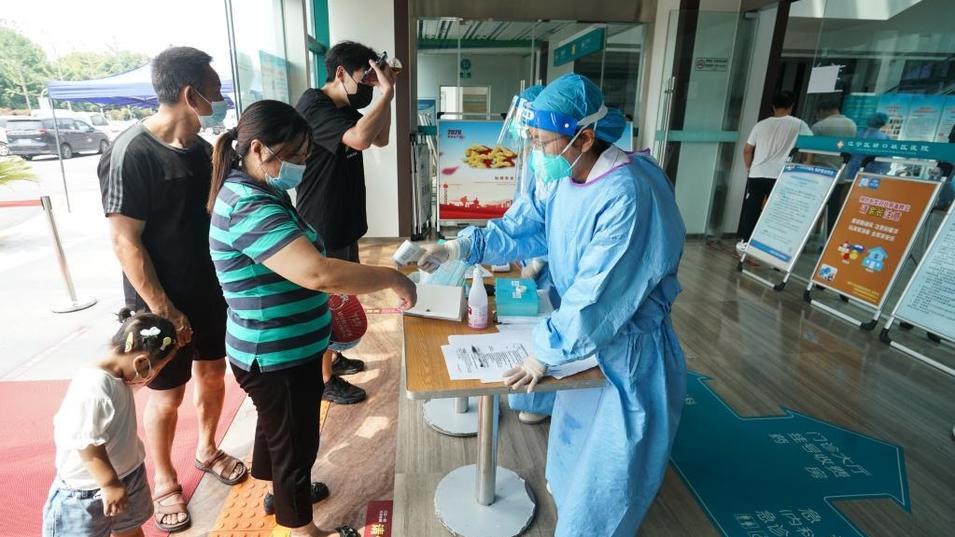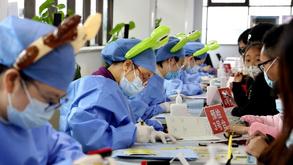 Staff members transfer materials at a residential area in Manzhouli, north China's Inner Mongolia autonomous region, Nov 29, 2021. (LI ZHIPENG / XINHUA)
Staff members transfer materials at a residential area in Manzhouli, north China's Inner Mongolia autonomous region, Nov 29, 2021. (LI ZHIPENG / XINHUA)
BEIJING - As the heavily mutated COVID-19 Omicron variant sounds a global alarm, China said it will stick to its strict anti-virus policy, taking all necessary measures to eliminate infections before the new virus variant could wreak havoc.
Cases of Omicron, a "variant of concern" according to the World Health Organization (WHO), have been reported in South Africa, Israel, Italy, Australia, and the United States, with multiple countries beginning to reinstate border restriction and travel bans.
ALSO READ: WHO says new strain is a variant of concern, names it Omicron
China has not detected such cases so far except in Hong Kong. Its health authority said the country will stick to its current anti-COVID strategy of preventing imported cases and a domestic resurgence, noting that such an approach is also effective against Omicron.
"No matter how the virus mutates, it is still the novel coronavirus," said Zhang Wenhong, head of the Center for Infectious Diseases at the Shanghai-based Huashan Hospital of Fudan University.
 A medical worker registers information of residents at a nucleic acid testing spot in Nanjing, capital of East China's Jiangsu province, July 29, 2021. (PHOTO / XINHUA)
A medical worker registers information of residents at a nucleic acid testing spot in Nanjing, capital of East China's Jiangsu province, July 29, 2021. (PHOTO / XINHUA)
Aiming to contain an outbreak within an incubation period, relevant Chinese agencies have been making full use of the "golden period," the first 24 hours of a discovered case, to find those who were in close contact, isolate potentially infected individuals before the virus spreads, or before the infected person can transmit the virus
"China's current quick response and strict anti-virus strategy can cope with various types of COVID-19 variants," he added
Chinese experts, however, did not relax their vigilance. They are closely tracking and assessing Omicron's transmission risks and its impact on existing vaccines and drugs.
Quick response
"To compete with highly contagious variants, the sooner we detect an infection, the sooner we can take the initiative to rid it out," Ma Xiaowei, director of the National Health Commission, told Xinhua.
All the local clustered cases in the COVID-19 resurgence since mid-October in China originated from overseas. The resurgence has spread to more than 20 provincial-level regions at its peak.
When dealing with these imported Delta variant cases, most regions managed to contain the outbreak within an incubation period of about 14 days.
Aiming to contain an outbreak within an incubation period, relevant Chinese agencies have been making full use of the "golden period," the first 24 hours of a discovered case, to find those who were in close contact, isolate potentially infected individuals before the virus spreads, or before the infected person can transmit the virus.
Ma hailed the strategy as an essential procedure for China's fight against COVID-19.
ALSO READ: WHO urges Asia-Pacific to ready for Omicron surge
 Residents have their body temperature checked at the entrance of a community hospital in Lukou subdistrict, Jiangning district of Nanjing, East China's Jiangsu province, Aug 26, 2021. (PHOTO / XINHUA)
Residents have their body temperature checked at the entrance of a community hospital in Lukou subdistrict, Jiangning district of Nanjing, East China's Jiangsu province, Aug 26, 2021. (PHOTO / XINHUA)
China has continuously adjusted its COVID-19 prevention and control measures: from the emergency response at the beginning of the outbreak, the exploratory routine containment until August, to the current strategy of eliminating COVID-19 infections in a timely manner
"Quick" has been a catchphrase during the whole process, as only through quick action can the spread of the virus be minimized.
Shanghai has lately managed to bring a virus resurgence under control in three days.
Immediately after the three cases were reported, authorities there activated an emergency response. The local government ordered epidemiological investigators to arrive at the scene within two hours, complete the core investigations within four hours, and finish the epidemiological reports within 24 hours.
Strict measures covering whole chain
China has continuously adjusted its COVID-19 prevention and control measures: from the emergency response at the beginning of the outbreak, the exploratory routine containment until August, to the current strategy of eliminating COVID-19 infections in a timely manner.
Alarmed by the loopholes exposed in the last resurgence of local infections, the central government has asked local authorities to strictly remain on guard against imported cases, enhance epidemic response capacity in key areas, limit tourist activities and promote mass vaccination.
ALSO READ: WHO: Blanket travel bans won't prevent Omicron spread
 Medical workers wearing cartoon head decorations work at a vaccination site in Xuhui district of Shanghai, east China, Nov 20, 2021. (LIU YING / XINHUA)
Medical workers wearing cartoon head decorations work at a vaccination site in Xuhui district of Shanghai, east China, Nov 20, 2021. (LIU YING / XINHUA)
More than 1.1 billion people in China had completed their COVID-19 vaccination, and health authorities are promoting their booster program nationwide.
The current strategy features targeted containment measures covering the whole chain of epidemic response.
China's practices in fighting COVID-19 show that effectively containing the virus, in a country with a population of more than 1.4 billion, is its biggest contribution to the global fight against the pandemic.
Ma Xiaowei, director of the National Health Commission
"We have been thinking, especially during the process of coping with the spread of the Delta variant, how to control the epidemic with more effective measures, lower costs and at faster speeds to minimize its impact on economic and social development and people's lives," Ma said.
The government has also noticed that the epidemic response in some countries, which have not implemented strict epidemic control measures, has not been satisfactory. There have been relapses that severely impacted people's lives, health and the economy and society overall.
"As a result, China has been focusing on improving epidemic prevention and early detection," Ma noted.
"China's practices in fighting COVID-19 show that effectively containing the virus, in a country with a population of more than 1.4 billion, is its biggest contribution to the global fight against the pandemic," he said.
 A medical worker inoculates a citizen with a booster shot of COVID-19 vaccine at a vaccination clinic in Fanyu district of Guangzhou city, south China's Guangdong province, Oct 18, 2021. (DENG HUA / XINHUA)
A medical worker inoculates a citizen with a booster shot of COVID-19 vaccine at a vaccination clinic in Fanyu district of Guangzhou city, south China's Guangdong province, Oct 18, 2021. (DENG HUA / XINHUA)
Xu Wenbo, an expert from the Chinese Center for Disease Control and Prevention, said Omicron spreads very fast based on the latest reported epidemiological data in South Africa. However, it could take weeks to figure out the variant's virulence.
READ MORE: S. Africa hit by fourth COVID-19 wave driven by Omicron
The mutation of the Omicron variant will not affect the sensitivity and specificity of China's major nucleic acid testing reagents, according to Xu.
Some Chinese companies have already launched early-stage planning on vaccines targetting Omicron.
Zhang Wenhong said China is accelerating scientific support to cope with new variants while taking advantage of the opportunities won by its current strategy.
"With science and solidarity, we have dealt with Delta well," Zhang said. "We can do the same with Omicron."


